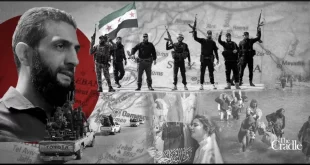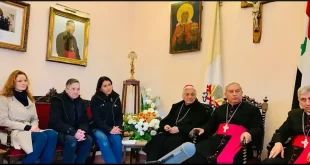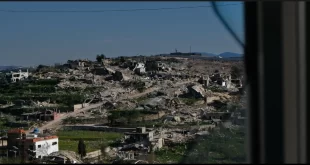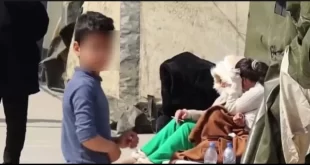by Steven Sahiounie, published on Mideast Discourse, September 8, 2023
A power struggle in the eastern Syrian desert might end with the US withdrawal from Syria, as the occupation allies battle each other for power and lucrative energy resources.
On August 27, Ahmed al-Khubail, the commander of the Deir ez-Zor Military Council (DZMC), was lured to Hasakah by the US sponsored Syrian Democratic Forces (SDF) on the pretext of a meeting. After arriving, Khubail, his brother Adham, and four other commanders were arrested and held.
Khubail is connected to the Arab tribe al-Bakir, and the ensuing response has left at least 50 SDF fighters dead, dozens wounded, and civilian dead after the SDF began shelling residential neighborhoods while battling the Arab tribes.
The lines in the sand have been drawn, and on one side is the US sponsored SDF who are Kurdish communists, while the other side are the tribes of al-Bakir, al-Shuhayl, al-Dulaym and Albu Khabur.
These Sunni Arab tribes had been coordinating with the SDF, but had always remained critical of the SDF primarily because the SDF are a Kurdish dominated paramilitary. In 2015 the US made the SDF their military partners in eastern Syria for the purpose of defeating ISIS. The US would sell you on the idea the US coalition defeated ISIS, but the reality it was the Syrian Arab Army, Russian military, Iranian military advisors, and Iraqi military along with the US and SDF which won the victory over the terrorists led by Baghdadi.
The SDF has a powerful military wing, YPG, which Turkey considers linked to the PKK, the banned terrorist group responsible for 30,000 deaths in Turkey over three decades. The US-SDF alliance caused Turkey to invade several times and occupy parts of Syria as a buffer zone to protect Turkish national security from the Kurds.
The US support of the SDF drove a deep wedge between usual allies, the US and Turkey, who view the US as state sponsors of terrorism for their support of the SDF and YPG.
In 2018 the SDF tried to remove Khubail from his position as commander, but the US military would not allow it. The US military is occupying a strategic piece of the eastern desert in Syria. President Trump ordered the US military to withdraw from Syria, but the Pentagon would not allow the order to stand. Instead, the US military remained illegally occupying prime real estate in the northeastern section which houses the biggest producing gas and oil fields, Omar and Conoco.
The domestic electricity in Syria is produced in power stations from both oil and gas, but since the US military and their partners SDF hold the area, the average Syrian home gets about three hours of electricity per day. The confiscated resources are shipped to the Kurdistan region of Iraq and sold. The money goes back to the SDF and the communist administration. The Arab tribes previously aligned with the SDF have long complained they did not get paid enough, and many would argue the current battles are about power and money.
But, the current violence runs deeper than just power and money. The root of the violence and dispute is about blood: ethnicity and identity.
The northeast region of Syria never had a Kurdish majority. The majority of the population there were Syrian Arab tribes and Syrian Christians, but there was a very large Kurdish community as well.
The Syrian Kurds watched as their ‘brothers’ in neighboring Iraq were successful in establishing a recognized ‘homeland’, the Kurdistan Region of Iraq. It was the US invasion and occupation of 2003 which gave the Iraqi Kurds the impetus to self-administration.
The 2015 US invasion and occupation of the northeast of Syria gave the Kurds hope to follow the lead of Iraq and through huge amounts of financial support, training and weapons the SDF, YPG, and their communist administration based in Qamishli began to think of themselves as semi-autonomous in the Syrian desert.
However, the Kurds’ weak-link has always been, and will always remain, the Syrian people they walked upon, tortured, raped, killed and maimed while carrying out an elaborate program of ethnic cleansing. Syrians displaced by the Kurds are living in Aleppo, Hama, Homs and Latakia just waiting for the day they can return to their homes, farms, lands and businesses. They yearn for the day when the US military packs up and goes to Iraq, leaving the Kurds defenseless and venerable. They look forward to day their rights can be restored.
The SDF and the US military like to blame everything on ISIS. They use the threat of ISIS as a weapon to brain-wash everyone into believing the US and SDF are justified. The truth is, there are just as many ISIS followers in USA as anywhere else, because ISIS is an ideology and is not confined to any one location. ISIS is part of the many factions following Radical Islam, which is a political ideology, and is not a religion, or a sect. The Muslim Brotherhood in USA, Europe, Turkey and Qatar are part of Radical Islam, as well as Mohammed al-Julani, the leader of HTS who holds 3 million people as hostages in Idlib, and is supported by Turkey.
Recently, the SDF accused Khubail of communicating with Turkey and Idlib, who are seen as the enemy by the SDF. However, others claim Khubail may have been communicating with Damascus.
According to James Jeffrey, the former US envoy to Syria, he gave the Kurds advice that their future lies in repairing their relationship with Damascus, and he cautioned them that the US government had no plans to recognize any “Syrian Kurdistan” they might be dreaming about.
The clashes may die down, and perhaps an uneasy truce will go into effect between the Kurds and the Arab tribes, but a wound has been opened up, and it will not easily heal given the depth of the hurt.
The US may have thought they found a Syrian partner on the ground to support the US planned regime change, but they chose a very weak, fragile ethnic group who are surrounded by enemies: Turkey and their own Arab neighbors. If the US occupation of Syria is depending on not only the SDF as allies, but the Arab tribes as well, then the Pentagon might need a re-think of their position: their alliances are crumbling like sand in the desert.
Steven Sahiounie is Syrian journalist, and a recipient of the Serena Shim Award for Uncompromised Integrity in Journalism.
 Syria Support Movement solidarity with the Syrian people
Syria Support Movement solidarity with the Syrian people





